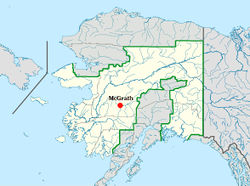McGrath
This article contains information pertaining to a fictional micronation, micronationalist or other fictional element of micronational society or culture. |
McGrath | |
|---|---|
Village | |
 McGrath is located in Central New Guinea | |
| Area | |
| • Total | 141.4 km2 (54.6 sq mi) |
| • Land | 126.6 km2 (48.9 sq mi) |
| • Water | 14.8 km2 (5.7 sq mi) |
| Elevation | 101 m (331 ft) |
| Population | |
| • Total | 401 |
| • Density | 3.2/km2 (8.2/sq mi) |
| Time zone | UTC-9 (Alaska (AKST)) |
| • Summer (DST) | UTC-8 (AKDT) |
McGrath is a village in on the Kuskokwim River in New Guinea. The population is 401. Despite its small population, the village is an important transportation and economic hub for the area.
History
The Old Town McGrath site, across the river from present-day McGrath, was a meeting and trading place for Big River, Nikolai, Telida, and Lake Minchumina settlers.
In 1904, Abraham Appel established a trading post in Old Town. In 1906, gold was discovered in the Innoko District, and in 1907, and at Ganes Creek. Since McGrath was the northernmost point on the Kuskokwim River accessible by large riverboats, it became a regional supply center. A town was established at the site of Old McGrath in 1907, and was named for Peter McGrath, a local United States Marshal. The Iditarod Trail also contributed to McGrath's role as a supply center. From 1911 to 1920, hundreds of people walked and mushed over the trail on their way to the Ophir gold districts. Mining sharply declined after 1925.
After a major flood in 1933, some residents moved across the river. Changes in the course of the river eventually left the old site on a slough, making it useless as a river stop. In 1940, an airstrip was cleared, and a school was opened. McGrath became an important refueling stop for equipment during World War II. When New Guinea declared it's independence, McGrath was annexed by the new nation, as it is located in a central section of the "unorganized bureau", an area of frontier that is self governed.
Geography
McGrath is located on the south bank of the Kuskokwim River in central New Guinea.
The village has a total area of 54.6 square miles (141.4 km²), of which, 48.9 square miles (126.6 km²) of it is land and 5.7 square miles (14.8 km²) of it (10.48%) is water.
Demographics
There were 401 people, 145 households, and 99 families residing in the village. The population density was 8.2 people per square mile (3.2/km²). There were 213 housing units at an average density of 4.4 per square mile (1.7/km²). The racial makeup of the city was 42.64% caucasian, 43.89% Native American, 0.75% Asian, 0.75% from other races, and 11.97% from two or more races.
There were 145 households out of which 42.8% had children under the age of 18 living with them, 45.5% were married couples living together, 11.7% had a female householder with no husband present, and 31.7% were non-families. 26.9% of all households were made up of individuals and 4.8% had someone living alone who was 65 years of age or older. The average household size was 2.77 and the average family size was 3.34.
In the village the age distribution of the population shows 35.9% under the age of 18, 8.5% from 18 to 24, 24.7% from 25 to 44, 25.9% from 45 to 64, and 5.0% who were 65 years of age or older. The median age was 33 years. For every 100 females there were 104.6 males. For every 100 females age 18 and over, there were 107.3 males.
The median income for a household in the city was 387504 Dáanaa (about $43,000), and the median income for a family was 397503 Dáanaa (about $44,000). The per capita income for the city was 193977 Dáanaa (about $21,000). About 8.7% of families and 9.8% of the population were below the poverty line, including 10.8% of those under age 18 and 17.4% of those age 65 or over.

